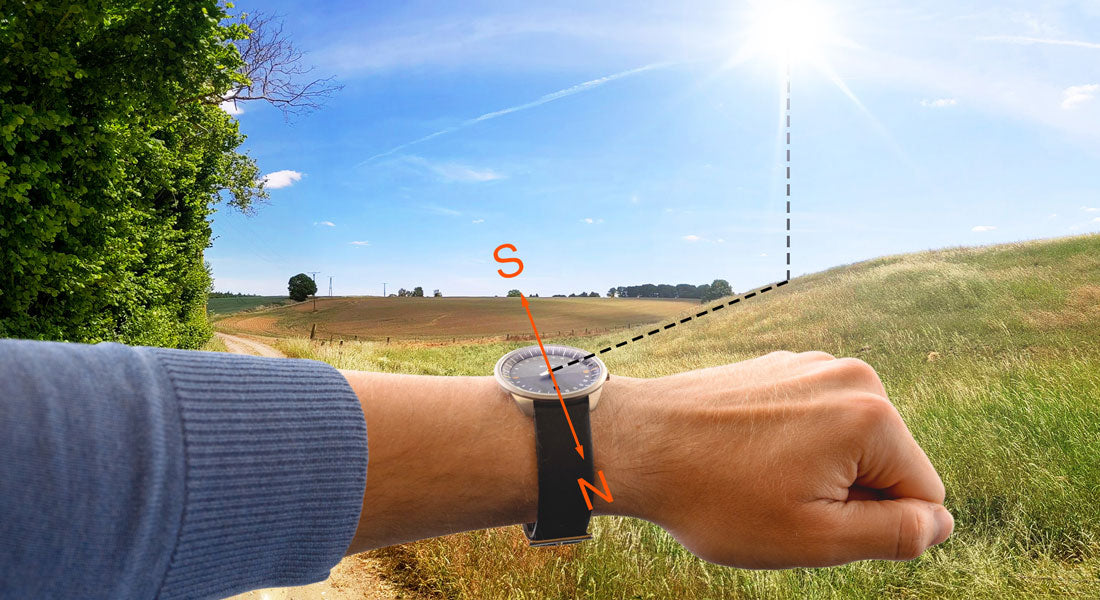An analog 24-hour one-hand watch is perfect for determining the exact cardinal point without a compass or GPS. It is even better than a compass which is not oriented to the geographical poles that are decisive for timekeeping *.
Of course, the method shown here also works with GMT watches and 24-hour watches by using the 24-hour hand. For GMT watches, the 24-hour hand must be set to the local time.
24-hour one-hand watch as compass
Part 1: Northern hemisphere

Proceed as follows:
Draw an (imaginary) line from the sun's position vertically down to the horizon. Note the intersection of this imaginary line with the horizon by means of a landscape feature (landmark). Hold the UNO 24 horizontally (parallel to the ground) and align the hour hand exactly in the direction of this landmark.
The 12-hour marker of UNO 24 now points exactly* to the south.
The other cardinal points are as follows: North is opposite the South and is followed clockwise by East, South and West. This scheme is of course identical on both halves of the earth.
Attention: During daylight saving time (+ 1 hour) on the northern hemisphere you read the southern position not on the 12 but on the 13 o'clock mark.
Part 2: Southern hemisphere

In the southern hemisphere, too, the cardinal points can easily be determined by means of UNO 24. Compared to the determination of cardinal points in the northern hemisphere, however, 3 factors change.
Here you proceed as follows:
Draw an imaginary line from the sun's position vertically downwards to the horizon. Again, note the intersection of this imaginary line with the horizon by means of a special landscape feature (landmark). Hold the UNO 24 horizontally (parallel to the ground) and align the 12-hour mark exactly in the direction of this landmark.
The hour hand of the UNO 24 now points exactly* to the north.
The other cardinal points are as follows: The north direction is followed by the cardinal points east, south and west in a clockwise direction.
Attention: If daylight saving time is currently in effect (+ 1 hour), the 13 instead of the 12 is aligned to the sun. Everything else remains the same.
Extraordinary time displays
The UNO24, a 24-hour one-hand watch that can be used as a compass, is just one example of the stringent logic (and nature reference) of BOTTA watches. Simple principles are usually more logical and in our case more unusual than conventional solutions. In the BOTTA-Quadrology you will find a well-structured overview of all our watches.
*) In principle, this way of determining the cardinal points is even more accurate than using a magnetic compass. The compass is based on the course of the earth's magnetic field lines. In reality, however, these deviate more or less clearly from the north-south orientation, which results in errors (misdirection).
The position of the sun, on the other hand, is an absolute value and, together with the time, forms a reliable parameter for navigation. It is not without reason that these exact astronomical values (position of the sun, angle of the sun, time of day) are also used for navigation at sea (see also sextant).
When determining the points of the compass using a 24-hour one-hand watch, the position within a time zone can be taken into account for even greater precision.The principle refers to the centre of a time zone.











2 comments
Hi botta-design.de owner, You always provide clear explanations and definitions.
Hi. I was elated to learn yesterday about this 24hr watch’s compass methodology. For the Southern hemisphere, I immediately compared the results of a 24 hour dial and a 12 hour dial at 15:00 or 3 pm. As expected, the North_South line was in the exact same position on the watch face. Since I can already calculate the rotational error correction for the 12 hour dial, in minute markings on the dial, I know by how much the North_South line should be rotated for a 24 hour dial, except for one problem: The 24 hour dial does not have the 60 minute markings per hour as for a 12 hour dial. To apply the correction and make life easy in the case of a 12 hour dial, I simply equate 60 minutes with 360°. For a 24 hour dial, the closest dial markings were spaced 10 minutes apart. This made applying the error correction as follows: 60 minutes = 360° = 24*60/10 = 72*2 = 144. So when I say correct the North_South line by 5 minutes with a 12 hour dial, I now have to say correct the North_South line by 12 (= 5/60*144) smallest dial divisions when wearing a watch with a 24 hour dial. It turns out that 12 divisions = “2 hours” rotation to correct the error. We’ll, I personally can plot 5 minutes on a 12 hour dial easier than 2 hours on a 24 hour dial – BECAUSE I GREW UP WITH A 12 HOUR DIAL. I assume from this 3 pm case, that the rest is just more of the same, though strictly speaking, the actual error would be arrived at differently. SO YES, EASIER TO DETERMINE NORTH ON A 24 HOUR DIAL, BUT NOT IF THE NORTH POINTER IS ALREADY BUILT INTO A WATCH WITH A 12 HOUR DIAL. TO CALCULATE THE ERROR, I COMPARE RESULTS WITH A SUN COMPASS THAT USES CALCULATED SUN AZIMUTH VALUES TO WORK. (I HAVE NOT YET LOOKED AT THE CASE OF A GMS WATCH)